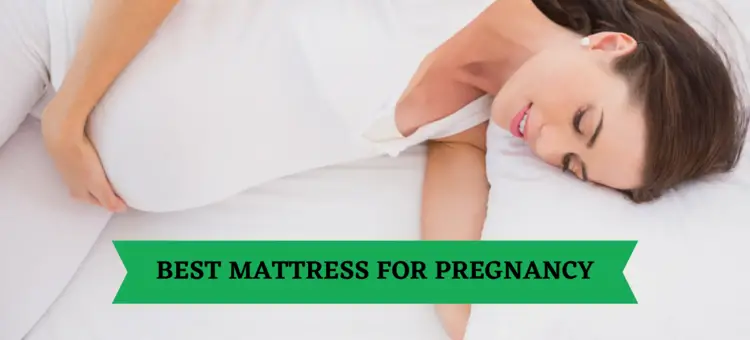In this, we discuss best mattress for pregnancy, Quality sleep for expectant mothers is important throughout pregnancy. Not only is it beneficial for the health of both mother and child, it also impacts delivery outcomes. With pregnancy, there is an increased likelihood of sleep disorders including insomnia, restless leg syndrome, and sleep apnea. Paired with physical, emotional, and hormonal changes, it can feel nearly impossible for pregnant women to get quality sleep each night. Poor sleep throughout pregnancy can result in longer labor with more discomfort. This makes getting enough sleep each night essential.
For pregnant women, the right mattress can make a significant difference. It can provide comfort for some of the side effects of pregnancy, and encourage restful sleep for expectant mothers. Since pregnancy increases core body temperature, expectant mothers may find they sleep hot. A mattress that regulates temperature can prevent overheating. Contouring and pressure point relief are crucial for proper spinal alignment and relieving lower back pain associated with pregnancy. Other factors, including firmness, edge support, and motion isolation, will also be important for pregnant women to consider.
We’ll cover our top mattress picks for women experiencing pregnancy, and what to look for when shopping for a new mattress. We also include sleep help tips for each trimester, as pregnant women’s sleep needs change throughout pregnancy.
Please remember that while our guide is thorough and well-researched, it is not a replacement for medical advice. Always consult your doctor or qualified physician with any questions or concerns you have regarding medical conditions, treatments, and advice.
Best Mattress for Pregnancy: Buying Guide
Buying a mattress can be a complicated process for anyone, but pregnant women face unique challenges. Their changing bodies need proper support. Pregnant women who are used to sleeping on their stomachs or backs may find those positions are no longer comfortable. A rise in their core body temperature can also cause them to sleep hot. These factors can determine what type of mattress is best for pregnancy, and should be considered before making a purchase.
How Does Pregnancy Affect Sleep?
Pregnancy affects sleep in multiple ways, both physically and mentally. As a result, a majority of pregnant women report sleep disturbances throughout their pregnancy. This includes insomnia, which makes it difficult to fall asleep or stay asleep. This can be caused by stress and anxiety, hormone changes, and other pregnancy symptoms. Certain sleep disorders are more likely in pregnancy, including restless leg syndrome and sleep apnea. Restless leg syndrome, which may be caused by an iron deficiency, causes discomfort in the legs and is typically worse at night. Pregnant women may feel the need to move their legs, making it difficult to get comfortable and fall asleep. Sleep apnea is the result of upper airway obstruction, and the risk of this increases later in pregnancy.
Many symptoms appear depending on the trimester of pregnancy, all of which can impact sleep quality. An increase in progesterone levels in early pregnancy can cause sleepiness throughout the day, but may interfere with sleep quality at night. The first trimester typically brings nausea and vomiting, commonly referred to as morning sickness. However, it can occur throughout the day and at night. Morning sickness usually subsides by the second trimester, though heartburn becomes more common.
In the second trimester, pregnant women can also feel fetal movements. Cramps, tingling in the legs, and shortness of breath are also common. Disturbances common in the second trimester are usually more pronounced in the third trimester. Back pain is common, and a growing belly makes it difficult to find a comfortable sleeping position. Pregnant women in the first trimester may feel the need to use the bathroom frequently, which can wake them up throughout the night. Anxiety about childbirth and parenting can also prevent pregnant women from sleeping soundly. While there are many ways in which pregnancy can affect sleep, a comfortable and supportive mattress can help alleviate some of these symptoms.
What Type of Mattress Is Best for Pregnant Women?
There are several types of mattresses, each of which offers benefits and drawbacks for pregnant women. When selecting a mattress, there are key factors to look for, including how well the mattress keeps the spine aligned, and how much comfort it provides. Symptoms of pregnancy that cause discomfort include back pain, sleeping hot, restlessness, and a tendency to use the bathroom frequently throughout the night. A mattress that relieves these symptoms, or at least does not aggravate them, can promote better sleep. Temperature regulation can prevent overheating, and is a common feature with latex and hybrid mattresses. Motion isolation will prevent sleep disturbances for people who share the bed, especially for women who get up often throughout the night. Edge support is also essential for those who sleep or sit on the edge of the bed. The following table outlines the different types of mattresses and what to expect from each.
Foam
Latex
Innerspring
Hybrid
Memory foam mattresses are constructed with comfort layers of viscoelastic memory foam and a polyfoam support base. Memory foam contours closely, as it responds to both heat and pressure. This body-hugging feel relieves pressure points and helps to keep the spine aligned. There are a few types of memory foam, including traditional, open cell, and gel-infused foam. While traditional memory foam retains heat, gel-infused and open cell foam regulate temperature better and draw heat away from the body.
Average Price:
mattresses have become more widely available, with an average price point of $500 to $1,000. Luxury models can cost up to $4,000. The price is often determined by the quality and density of the foams used.
Pros for Pregnant Women:
- The conforming nature of memory foam relieves pressure points and helps keep the spine aligned. This can relieve back pain caused by pregnancy.
- Memory foam isolates motion, preventing movements from transferring across the bed and disturbing a partner. This is helpful for pregnant women who share the bed and have to get up often throughout the night.
- Memory foam cushions the shoulders and hips, which offers support for side sleepers. By the second trimester of pregnancy, most women sleep on their side.
Cons for Pregnant Women:
- Memory foam retains heat and can restrict airflow around the body. This results in the feeling of sleeping hot, which is not ideal for pregnant women as their core temperature is already higher than normal.
- Memory foam is known for minor off-gassing. This synthetic smell can bother pregnant women who are sensitive to odors.
Important Factors to Consider When Buying a Mattress
Selecting the right mattress can be a tough decision, especially with so many options on the market. There are many factors to keep in mind when buying a mattress. Support and comfort are the two most important elements in a mattress, especially for pregnant women. Support keeps the spine aligned, which helps relieve back pain and relieve common pressure points. Comfort will mean different things to each person, as everyone has unique needs and preferences. For pregnant women, this may include a mattress that regulates temperature, isolates movement, and offers edge support. The following elements should all be considered when mattress shopping.
- Support: Pregnant women carry more weight in their midsection, which puts pressure on their lower back. Support indicates how well the mattress keeps the spine aligned, which can take pressure off the back and alleviate aches and pains. The mattress should be flat and even, without any sagging or deep indentations. This will provide full-body support, which is necessary throughout pregnancy and after.
- Contouring: A mattress that contours to the shape of your body offers a customized feel. Contouring also relieves pressure points, and can alleviate minor aches and pains. Memory foam is known for its contouring properties, though it can restrict airflow if it conforms too closely. Latex is more breathable, so it is less likely to retain heat and restrict airflow while still contouring to the shape of your body.
- Firmness: Firmness is typically rated on a scale of 1 to 10, or extremely soft to extremely firm. Most mattresses are medium to medium firm, though soft and firm options are available. For pregnant women, medium firm mattresses typically offer a balance of full-body support and conforming comfort. It also cushions pressure points, including the shoulders and hips, which is ideal for pregnant women who sleep on their sides.
- Motion Isolation: Movements can transfer across the bed, so pregnant women shifting positions to get comfortable, or those who need to get up throughout the night, may disturb their partners. Motion isolation prevents movements from rippling across the bed and minimizes sleep disturbances. Memory foam isolates movement well, while innerspring coils are more likely to transfer movement.
- Temperature Regulation: Since overall body temperature slightly increases during pregnancy, some women may experience sleeping hot. Breathable materials help air circulate throughout the mattress, which can help keep your body at a comfortable temperature. While traditional memory foam may retain heat, latex and hybrid mattresses typically prevent overheating.
- Edge Support: Edge support makes it easier to get in and out of bed, which is especially important for pregnant women as their bodies change. A reinforced perimeter prevents sinking in or sagging along the edges. Innerspring and hybrid mattresses are more likely to have reinforced perimeters, while memory foam mattresses typically lack edge support.
- Noise: Many pregnancy symptoms cause restlessness, and pregnant women may often change positions or get in and out of bed. A mattress that makes noise can cause sleep disturbances for pregnant women who share the bed with a partner. Memory foam and latex mattresses are silent when bearing weight, while innerspring mattresses are more likely to make noise.
- Price: Prices vary between manufacturers and mattress types, so be sure to determine a budget before shopping. Parents-to-be face many new expenses, and a mattress is certainly an investment. A high-quality, durable mattress will last throughout the pregnancy and beyond.
Sleep Help and Tips for Pregnant Women
Throughout pregnancy, women experience physical, hormonal, and emotional changes. Adjusting to a changing body can make it difficult to get a good night’s sleep. The following sleep tips can help pregnant women get better sleep. Which trimester you are in often dictates the biggest sleep disturbances and issues, so we’ve broken down our tips by time frame.
First Trimester
Though certain hormones increase throughout pregnancy, your body usually has had time to adjust by the second trimester, lasting from weeks 14 to 27. While morning sickness has usually tapered off, heartburn becomes more likely. To prevent heartburn from disturbing your sleep, avoid spicy foods. You can also use pillows to elevate your head at night, which prevents acid reflux.
Vivid dreams are also more common in the second trimester. Relaxing before bed can improve sleep quality. Learning meditation techniques can also help you unwind if you wake up throughout the night. Stretching can also help pregnant women relax, and may prevent leg cramps that are common in pregnancy. Since pregnant women have a tendency to sleep hot, breathable bedding that wicks away heat and moisture can help keep them comfortable.
Third Trimester
The third trimester of pregnancy lasts from week 28 to birth. With a growing belly, pregnant women are more likely to feel overall discomfort. There is added strain on the lower back, which causes aches and pains. A mattress that properly supports the spine can alleviate some of this pressure while you sleep. Symptoms that were present in the first and second trimesters, including frequent urination and heartburn, are common in the third trimester as well. Staying hydrated and avoiding spicy foods is still recommended.
Restless leg syndrome is more common in the third trimester, so testing your iron levels may be recommended if you experience this. Daily exercise can improve sleep quality and offset some of the symptoms of pregnancy. Establish a daily routine that keeps you active, and a nightly routine that helps you unwind and relax.
Postpartum
Women still need quality sleep after childbirth. In fact, postpartum is often referred to as the fourth trimester. This period of time can be difficult as you adjust to a sleep schedule with a newborn. Breastfeeding can encourage sleep postpartum. Be sure to get sleep when you can and ask for help when you need it. If you are raising your child with a partner, work with them to establish a schedule that lets both of you get much-needed rest.
Throughout pregnancy and after childbirth, it is important to discuss changes and concerns with your doctor. Sleep is important for your health and wellbeing, and a medical professional can help devise a treatment plan and address your specific concerns.
Additional Sleep Accessories for Pregnant Women
While a mattress is the most important purchase for improving sleep health, there are additional accessories that can be used to customize your sleep environment. These products can help alleviate symptoms of pregnancy and provide additional comfort.
Throughout pregnancy and after childbirth, it is important to discuss changes and concerns with your doctor. Sleep is important for your health and wellbeing, and a medical professional can help devise a treatment plan and address your specific concerns.
Pillows
Pillows can be used strategically throughout pregnancy to alleviate symptoms like heartburn, back pain, and breathing issues. Propping up your head with a comfortable pillow can reduce snoring and open the airway. This also prevents acid reflux, which is common in the second and third trimesters. Since pregnant women are advised to sleep on their side, a higher loft pillow will keep their head, neck, and spine aligned. Pillows can also be used to prop up your legs and square your hips.
For full-body support and more adjustability, a body pillow may be a wise investment. These pillows are longer, and can be used to support multiple areas like the stomach, back and legs. They are versatile and supportive. Many pregnant women use body pillows to keep their body as an angle and prevent turning onto their back as they sleep. Sleeping on your back causes pressure on a main vein, which can reduce oxygen and blood flow.
Throughout pregnancy and after childbirth, it is important to discuss changes and concerns with your doctor. Sleep is important for your health and wellbeing, and a medical professional can help devise a treatment plan and address your specific concerns.
Mattress Toppers
For budget-conscious shoppers, or for people who bought a new mattress pre-pregnancy and now want to customize its feel, a mattress topper may be a good option. A mattress topper is a thick comfort layer that sits on top of your current mattress. It can be attached with straps or secured in place with a fitted sheet. A topper changes the overall firmness and feel of your current mattress. It can also improve temperature regulation, motion isolation, and pressure point relief. Though mattress toppers are available in a wide range of materials, memory foam or latex is ideal for pregnancy. These materials offer contouring support and isolate movement.
Mattress toppers can extend the lifespan of your mattress by preventing wear and tear. However, this accessory cannot fix a broken mattress. If your mattress is sagging in areas, investing in a new mattress is recommended.
For full-body support and more adjustability, a body pillow may be a wise investment. These pillows are longer, and can be used to support multiple areas like the stomach, back and legs. They are versatile and supportive. Many pregnant women use body pillows to keep their body as an angle and prevent turning onto their back as they sleep. Sleeping on your back causes pressure on a main vein, which can reduce oxygen and blood flow.
Throughout pregnancy and after childbirth, it is important to discuss changes and concerns with your doctor. Sleep is important for your health and wellbeing, and a medical professional can help devise a treatment plan and address your specific concerns.







